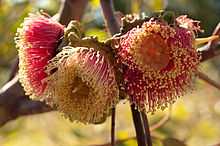Eucalyptus youngiana
| Large-fruited Mallee | |
|---|---|
 | |
| Scientific classification | |
| Kingdom: | Plantae |
| (unranked): | Angiosperms |
| (unranked): | Eudicots |
| (unranked): | Rosids |
| Order: | Myrtales |
| Family: | Myrtaceae |
| Genus: | Eucalyptus |
| Species: | E. youngiana |
| Binomial name | |
| Eucalyptus youngiana F.Muell. | |
Eucalyptus youngiana, commonly known as Large-fruited Mallee, Ooldea Mallee and Yarldarlba,[1] is a tree that occurs in arid and semi-arid areas of southern Western Australia and South Australia.
Description
E. youngiana grows as a mallee from four to ten metres high, with rough, flaky bark and red or yellow flowers from June to October.[2]
Taxonomy
The species was first published in 1876 by Ferdinand von Mueller,[3] based on specimens collected at Queen Victoria Spring by Jess Young during the Giles expedition of May 1875.[4] The specific name honours Young.
There are no subspecies or varieties. In 1969 Clifford Boomsma demoted it to a subspecies of E. pyriformis, but this was overturned by Ian Brooker in 2000.[3]
Distribution and Habitat
It has a fairly wide distribution, occurring throughout arid and semi-arid areas of Western Australia and South Australia. It is commonly found in the Great Victoria Desert ecosystem. The relief is generally gentle slopes. It grows in red sands and sandy loams.[2]
References
- ↑ "Australian Plant Common Names Database". Retrieved 2007-04-12.
- ↑ 2.0 2.1 "Eucalyptus salubris". FloraBase. Department of Environment and Conservation, Government of Western Australia.
- ↑ 3.0 3.1 "Eucalyptus youngiana F.Muell.". Australian Plant Name Index (APNI), IBIS database. Centre for Plant Biodiversity Research, Australian Government.
- ↑ Hall, Norman (1978). Botanists of the Eucalypts. Australia: Commonwealth Scientific and Industrial Research Organisation. ISBN 0643002715.